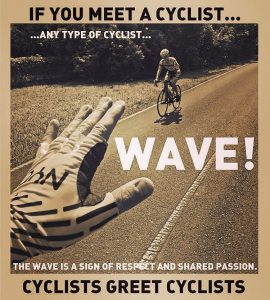Are you a “waver”?

I am. And I cross paths with several on my commute every morning. I have no idea who they are, but there are two bicyclists and even one motorcyclist with whom I exchange waves or called-out hellos or good-mornings – same time, same place, every day. It’s one of the many charms of bike commuting.
There is a human element unique to riding a bike. We are not enclosed in a box, invisible and limited to turn signals and horns for communication. The next time you’re riding in a vehicle, think about how easy it is to forget that every other vehicle on the road has a person in it. Find any news source and read about “cars” crashing into things, as though they are already self-driving. The person is subsumed into the machine. Vehicle drivers feel so invisible in their cars that they’re even comfortable picking their noses in plain sight of others. (Try that on your bike at a red light sometime.)
But a bicyclist is immediately and recognizably human. We can communicate with gestures as nuanced as a quick head nod. We can vary our vocalizations from a hello to a yell. We’re being judged for what we wear, for good or ill. We can make eye contact with everyone.
I wave at other cyclists to affirm this humanity. I wave or say hello or nod because, even if I don’t know you, I know that you share my passion for bikes. I like you already. You should come to BicycLincoln’s Commuter Club, and we should have a beer together. (Shameless event plug!)
But, for as often as I wave at people on bikes, I wave at drivers far more. In many ways, it’s even more important. By communicating with drivers, you’re (metaphorically) smashing down that box around them and reminding them that they are a human and that you are a human – not an obstacle, not a nuisance. You are their coworker or their neighbor or their friend.
Sometimes the communication is purely practical: You use your arm to signal a turn; you gesture for them to go ahead when you have the stop sign and they try to wave you through. Do this sort of communicating as much as you can. It makes you safer, it makes you a more predictable road user, and it makes us all look good.
A friendly wave, however, is an art. Just as the reckless behavior of one bicyclist will make a driver want to take out their wrath on the next two-wheeled thing they see, a friendly wave will spread warm fuzzies that – we hope! – extend to their future interactions with people on bikes. It’s simple. It’s free. It makes everyone involved feel good.
The next time you’re riding and you see a vehicle driver do something good, reward this gold-star behavior with a friendly wave. For example:
- You have a stop sign; they don’t. They see you coming and they wait, even though they probably could have taken off just before you got there.
- Their vehicle is blocking the crosswalk while they wait at a stop sign, but they move it back so that you can cross.
Any time you see a vehicle driver watch out for you, give them a quick thanks. They deserve it. And when you see other people on bikes, greet them like the awesome people they are.
